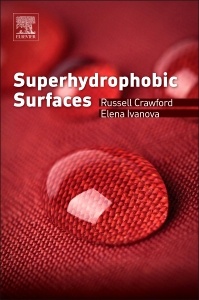Superhydrophobic Surfaces
Auteurs : Crawford Russell J., Ivanova Elena P.

Superhydrophobic Surfaces analyzes the fundamental concepts of superhydrophobicity and gives insight into the design of superhydrophobic surfaces. The book serves as a reference for the manufacturing of materials with superior water-repellency, self-cleaning, anti-icing and corrosion resistance. It thoroughly discusses many types of hydrophobic surfaces such as natural superhydrophobic surfaces, superhydrophobic polymers, metallic superhydrophobic surfaces, biological interfaces, and advanced/hybrid superhydrophobic surfaces.
1. The concept of superhydrophobicity2. Natural superhydrophobic surfaces3. Soil wettability4. Superhydrophobic polymers5. Metallic superhydrophobic surfaces6. Insights into the design of superhydrophobic surfaces7. Biological interfaces8. Advanced /hybrid superhydrophobic surfaces
Researchers in academia and industry and chemical engineers working in surface chemistry, physical chemistry, biochemistry, materials science, (micro)biology, nanotechnology, medicine, and dentistry.
Professor Elena P. Ivanova received PhD from the Institute of Microbiology and Virology, Ukraine; ScD from the Pacific Institute of Bio-organic Chemistry, RF; JD from the Melbourne University. EI worked at Osaka National Research Institute, AIST (Japan) as a Postdoctoral Fellow; at the Center of Marine Biotechnology, University of Maryland, USA; and joined Swinburne University of Technology, Australia in 2001. Recipient of AIST, JSPS and UNESCO Fellowships; Research Excellence Award Governor of Primorye (RF, 1998), Morrison Rogosa Award, ASM; Prominent Young Doctor of Science Award, RAS, RF; author and co-author of 200+ research papers, patents, books and book chapters. Professional interests are concentrated on development and coordination of research in fundamental and applied fields of Bio/nano/technology.
- Provides an adequate blend of complex engineering concepts with in-depth explanations of biological principles guiding the advancement of these technologies
- Describes complex ideas in simple scientific language, avoiding overcomplicated equations and discipline-specific jargon
- Includes practical information for manufacturing superhydrophobic surfaces
- Written by experts with complementary skills and diverse scientific backgrounds in engineering, microbiology and surface sciences
Date de parution : 02-2015
Ouvrage de 180 p.
15x22.8 cm
Thèmes de Superhydrophobic Surfaces :
Mots-clés :
Biological interactions; Biotechnology; Cassie-Baxter state; Cell attachment; Chirality; Fabrication; Hierarchical; Insects; Light-matter interaction; Nanostructures; Nanotextured surfaces; Nanotopography; Natural; Natural systems; Nonwetting soils; Plants; Polymer brush; Self-cleaning; Soil organic matters; Soil water repellency; Superhydrophobic; Superhydrophobic materials; Superhydrophobic metallic surfaces; Superhydrophobic polymer; Superhydrophobic soils; Superhydrophobic surfaces; Superhyd



